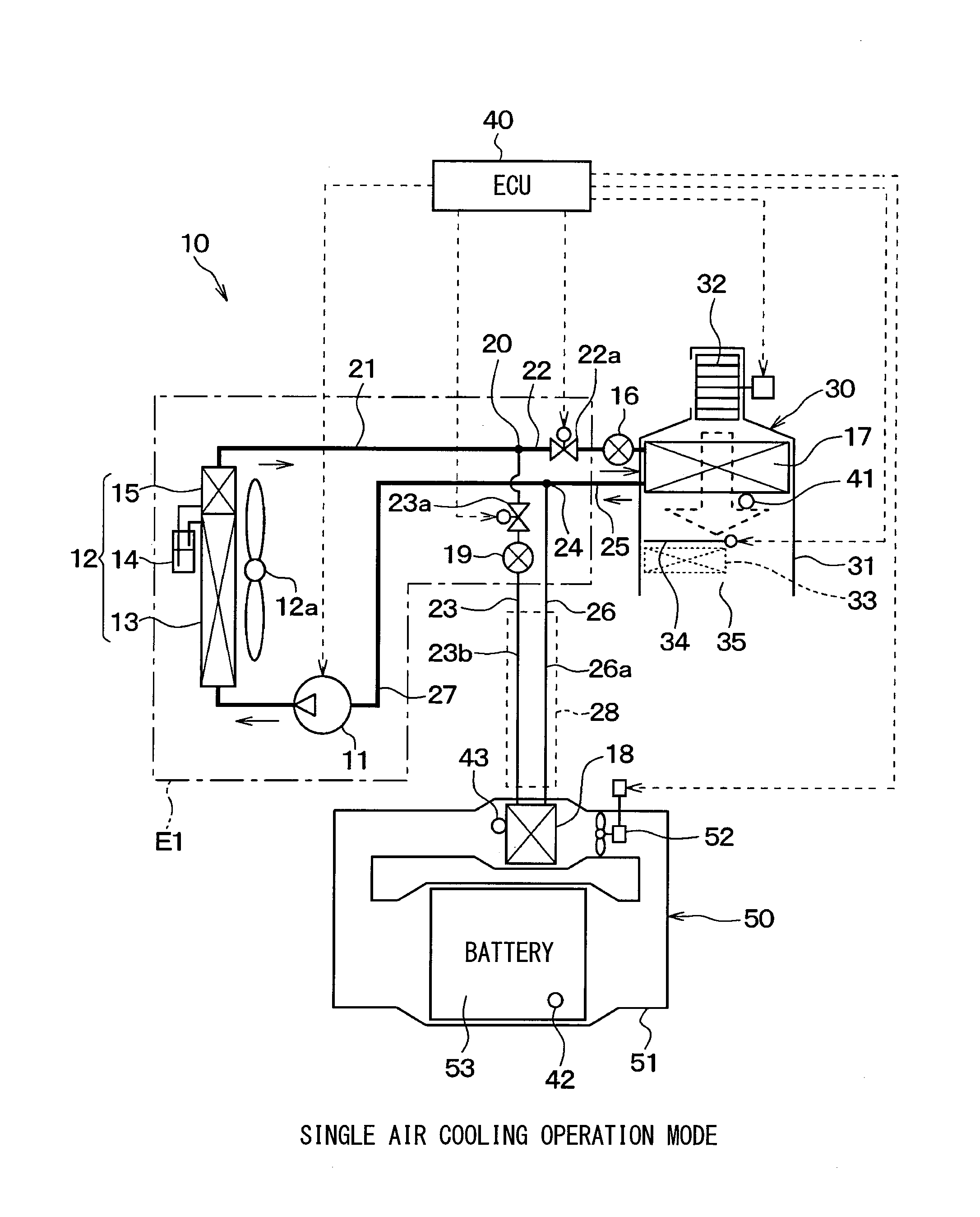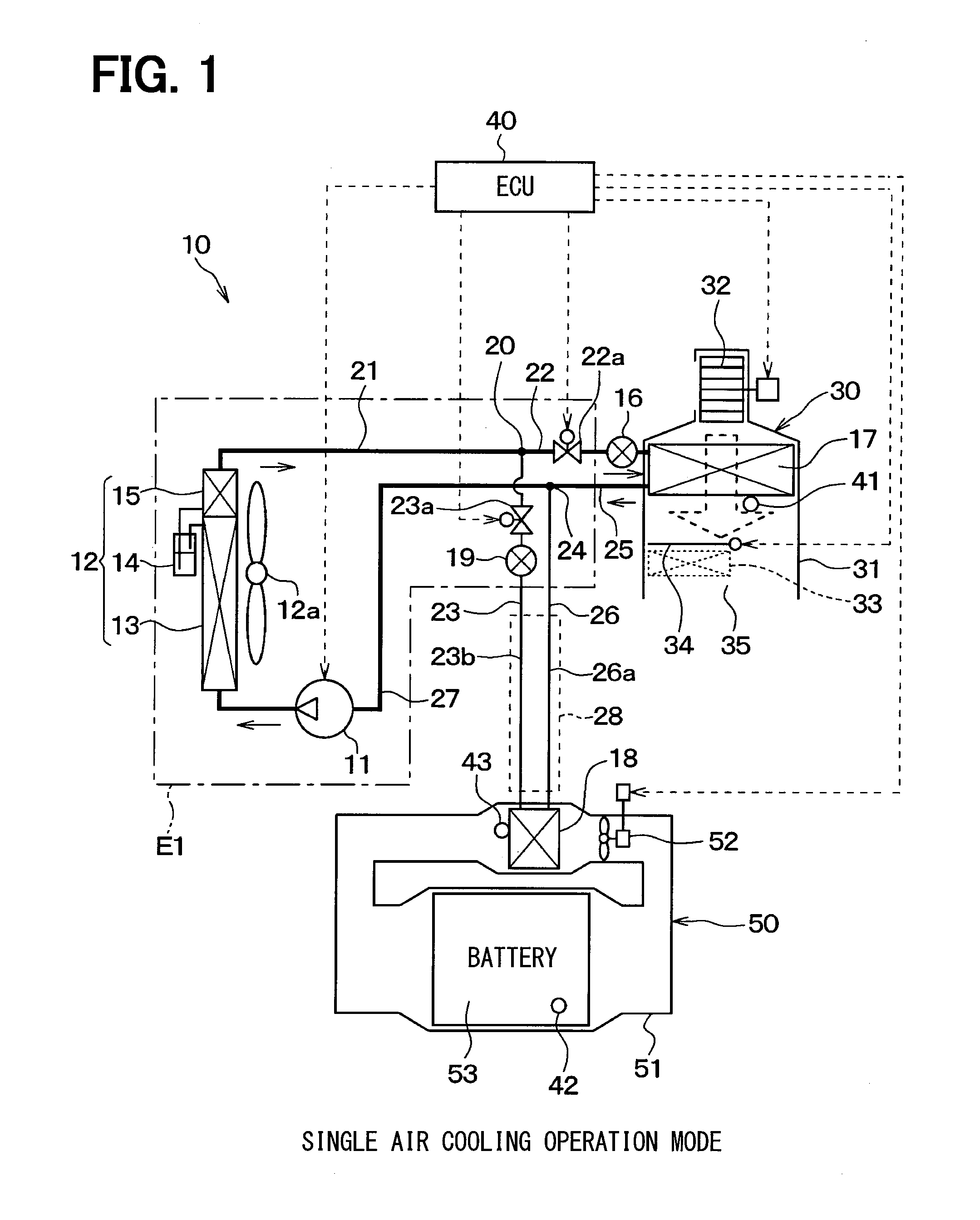Refrigeration cycle device
a technology of refrigerant cycle and device, which is applied in the direction of subcoolers, transportation and packaging, light and heating equipment, etc., can solve the problems of increasing the volume of the device storing the excessive amount of refrigerant in the cycle, and increasing the cost of refrigeran
- Summary
- Abstract
- Description
- Claims
- Application Information
AI Technical Summary
Benefits of technology
Problems solved by technology
Method used
Image
Examples
first embodiment
[0033]In a first embodiment, a refrigeration cycle device 10 according to the present disclosure is applied to a hybrid vehicle that can obtain a driving force for vehicle traveling from both an electric motor for traveling and an internal combustion engine. As shown in FIGS. 1 to 3, the hybrid vehicle uses the refrigeration cycle device 10 to cool the vehicle interior and also to cool a secondary battery 53 that stores therein electric power to be supplied to the electric motor for traveling.
[0034]The refrigeration cycle device 10 has a structure that includes a receiver cycle for air conditioning as a basic cycle, to which a secondary battery cooling function is added. The basic cycle has various devices, including a compressor 11, an exterior condenser 12, an air-cooling expansion valve 16, and an interior evaporator 17. These respective devices are connected together by refrigerant pipes. In the basic cycle, a battery-cooling evaporator 18 is disposed in parallel to the interior...
second embodiment
[0127]In the first embodiment, a receiver cycle that intends to perform air cooling is used as the basic cycle of the refrigeration cycle device 10. However, in a second embodiment as shown in FIG. 10, a heat pump cycle capable of performing both air cooling and heating is used. The structures of other components in the second embodiment are the same as those in the first embodiment.
[0128]The heat pump cycle is an accumulator cycle using an accumulator 61 instead of the gas-liquid separator 14 of the first embodiment. The heat pump cycle includes, in addition to the compressor 11, the exterior condenser 12, the air-cooling expansion valve 16, and the interior evaporator 17, an interior condenser 62, an air-heating expansion valve 63, a check valve 64 provided in the refrigerant flow path 21, and a bypass opening / closing valve 65a provided in a bypass flow path 65.
[0129]The accumulator 61 is a gas-liquid separator that separates the refrigerant, which is to be sucked into the compres...
third embodiment
[0135]Although in the second embodiment, the heat pump cycle capable of performing both the air cooling and heating operations is used as the basic cycle of the refrigeration cycle device 10, a third embodiment uses an accumulator cycle that performs only an air cooling operation as shown in FIG. 11.
[0136]The accumulator cycle omits the interior condenser 62, the air-heating expansion valve 63, the check valve 64, the bypass flow path 65, and the bypass opening / closing valve 65a from the accumulator cycle shown in FIG. 10. Also, the third embodiment can exhibit the same effects as those of the first embodiment.
PUM
 Login to View More
Login to View More Abstract
Description
Claims
Application Information
 Login to View More
Login to View More - R&D
- Intellectual Property
- Life Sciences
- Materials
- Tech Scout
- Unparalleled Data Quality
- Higher Quality Content
- 60% Fewer Hallucinations
Browse by: Latest US Patents, China's latest patents, Technical Efficacy Thesaurus, Application Domain, Technology Topic, Popular Technical Reports.
© 2025 PatSnap. All rights reserved.Legal|Privacy policy|Modern Slavery Act Transparency Statement|Sitemap|About US| Contact US: help@patsnap.com



